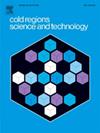冻结温度下冰碛土的电阻率和未冻水含量:实验和热力学模型
IF 3.8
2区 工程技术
Q1 ENGINEERING, CIVIL
引用次数: 0
摘要
不同冻结温度下的未冻水含量是表征土壤冻结过程中电阻率特性的主要参数。以西藏东南部嘎隆格拉冰川冰碛土为研究对象,利用核磁共振(NMR)技术和LCR数字桥测试仪,研究了不同水分和细颗粒含量下冰碛土的电阻率、未冻水和冻结温度之间的复杂关系。确定了冰碛岩孔隙水的冰点和水分特征阈值。结合三元电导率理论,建立了冰碛土的非冻结水与电阻率的理论模型,揭示了冰碛土冻结过程中的导电机理。结果表明:冰碛土电阻率与含水率呈负指数相关,随冻结温度的降低而增大;在相同温度条件下,含水率比细颗粒含量对电阻率的影响更显著。在冻结过程中,冰碛土的未冻水经历了缓慢下降、快速下降和稳定三个不同的阶段。冰碛土中体积水的冰点范围为0 ~−2℃,毛细水的冰点范围为−2 ~−4℃,松散结合水的冰点范围为−4 ~−6℃,据此确定了两个T2阈值,定量区分了冰碛土孔隙水的类型。考虑不同冻结状态下冰碛土的内部回路原理,建立了负温条件下冰碛土电阻率与未冻水含量的理论模型,并进行了可靠性验证。该研究为揭示寒区冰碛路基热液效应及其灾变机制提供了科学依据。本文章由计算机程序翻译,如有差异,请以英文原文为准。
Resistivity and unfrozen water content of moraine soil at freezing temperatures: experiments and thermodynamic modeling
The unfrozen water content at different freezing temperatures is the main parameter that characterizing the electrical resistivity properties during soil freezing. This study focuses on moraine soil from the Galongla Glacier in southeastern Tibet, utilizing nuclear magnetic resonance (NMR) technology and an LCR digital bridge tester to examine the intricate relationships between resistivity, unfrozen water, and freezing temperature under varying moisture and fine particle contents. The freezing points of pore water in moraines and the moisture characteristic threshold were also determined. A theoretical model of unfrozen water and resistivity was proposed in conjunction with the ternary conductivity theory, and the electrical conduction mechanism of moraine soil during freezing was revealed. The results showed that the resistivity of moraine soil exhibited a negative exponential correlation with moisture content and increase as the freezing temperature decreased. Under identical temperature conditions, moisture content has a more significant influence on resistivity than fine particle content. During the freezing process, the unfrozen water of moraine soil was observed to progress through three distinct phases, including slow decline, rapid decline, and stabilization. The freezing point of bulk water in moraine soil ranged from 0 to −2 °C, that of capillary water ranged from −2 to −4 °C, while that of loosely bound water ranged from −4 °C to −6 °C, according to which the two T2 thresholds were identified to quantitatively differentiate between the types of pore water in moraine soil. By considering the internal circuit principles of moraine soil at different freezing states, a theoretical model for resistivity and unfrozen water content under negative temperature conditions was developed and verified for reliability. This study provides a scientific basis for revealing the hydrothermal effects and catastrophic mechanisms of moraine roadbeds in cold regions.
求助全文
通过发布文献求助,成功后即可免费获取论文全文。
去求助
来源期刊

Cold Regions Science and Technology
工程技术-地球科学综合
CiteScore
7.40
自引率
12.20%
发文量
209
审稿时长
4.9 months
期刊介绍:
Cold Regions Science and Technology is an international journal dealing with the science and technical problems of cold environments in both the polar regions and more temperate locations. It includes fundamental aspects of cryospheric sciences which have applications for cold regions problems as well as engineering topics which relate to the cryosphere.
Emphasis is given to applied science with broad coverage of the physical and mechanical aspects of ice (including glaciers and sea ice), snow and snow avalanches, ice-water systems, ice-bonded soils and permafrost.
Relevant aspects of Earth science, materials science, offshore and river ice engineering are also of primary interest. These include icing of ships and structures as well as trafficability in cold environments. Technological advances for cold regions in research, development, and engineering practice are relevant to the journal. Theoretical papers must include a detailed discussion of the potential application of the theory to address cold regions problems. The journal serves a wide range of specialists, providing a medium for interdisciplinary communication and a convenient source of reference.
 求助内容:
求助内容: 应助结果提醒方式:
应助结果提醒方式:


